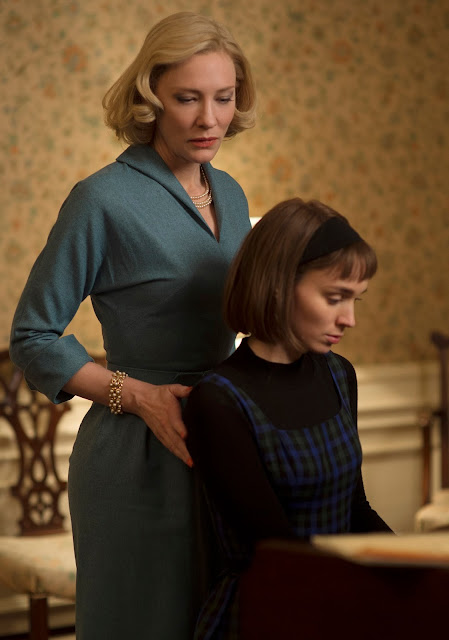A movie blog written by someone smart enough to know his opinions may not match yours.
WATCH THE TRAILER(S) HERE:
KEY CAST MEMBERS: Cate Blanchett, Rooney Mara, Sarah Paulson, Kyle Chandler, Jake Lacy, Cory Michael Smith and Carrie Brownstein
WRITER(S): Phyllis Nagy (screenplay); Patricia Highsmith (novel The Price of Salt on which the film is based)
DIRECTOR(S): Todd Haynes
60 SECOND PLOT SUMMARY (OR AS CLOSE TO THAT TIME AS ONE CAN MAKE IT): An adaptation of Patricia Highsmith’s 1952 novel The Price of Salt, Carol stars Rooney Mara as Therese Belivet, a rather quiet, introverted clerk working at a New York City department store. Then she meets Carol (Cate Blanchett), a woman that is seemingly everything she isn’t in terms of being confident and glamorous, save for one commonality between them: Attraction. The men in their lives, however – be it Carol’s head-over-heels but oblivious boyfriend (Jake Lacy) or Carol’s controlling, moral-thumping husband (Kyle Chandler) – are none too keen of the situation once they become aware something is going on between their would-be other halves.
But for Carol and Therese, an attraction as strong as the one they share is going to be hard to quell, the wishes of men or society be damned …
But for Carol and Therese, an attraction as strong as the one they share is going to be hard to quell, the wishes of men or society be damned …
WHO WILL LIKE THIS FILM THE MOST? Ohioans who worked on or know people in the film; LGBT community members and supporters; Cate Blanchett fans; people who enjoy watching portrayals of understudied segments of mid-20th century America; fans of Patricia Highsmith’s work
WHO WON’T (OR SHOULDN’T) LIKE THIS MOVIE? Anyone upset about Cincinnati’s decision to be the first city in the nation to ban homosexual conversion therapy; people who feel a disconnect to the story because of their own personal beliefs and/or not being a member of the LGBT community, thus not having the same emotional connection to the story as others; people who believe homosexual relationships are directly related to the dissolution of the American family … And pretty much anyone else you can think of who hears the word “lesbian” or “gay” and chuckles or goes into a rage
SO, IS IT GOOD, BAD OR ABSOLUTELY AWFUL? Carol is a film about which some people will have plenty to say and others, very little. For on one hand, some could easily dismiss the film as a very nice looking tale of a May-December (or more like May–October) romance between two women that doesn’t go far enough in exploring its affects on its main characters outside of one speech in a lawyer’s office and conversation between its female protagonists. Those same people may then look to quickly say something to the effect of Blanchett is commanding of the camera as Carol, a woman who in one breath is as confident and alluring and then, in the next, vulnerable as one can be when awaiting someone to whom you want to give your heart and not knowing they will return the favor.
Likewise, Mara – who is so adept at playing introverted or mysterious that she’s even talked about it on national television – is great at bringing at, on the surface, is a rather mundane character to life even if she seemingly spends most of the time reacting to things happening around her until she is placed into the role to make a very important decision … Even if she is guided inadvertently to that decision by Carol’s hand.
On the other hand, there is a LOT one could say about Carol one could discuss at length, from the depiction of men in the film to its status as a romantic drama vs. being a “lesbian romance” film – Salon.com already took the liberty of doing that if you want to examine those issues – to less hot-button topics such as its pacing, the transformation of Cincinnati into 1950s New York City and the like. Other might lament the film not going deeper into exploring the outside forces on Carol and Therese’s relationship or explaining exactly what happened between Carol and her best gal pal Abby (Sarah Paulson).
Then again, an infinite number of essays could be written about these topics, what the true realities of being in a lesbian relationship during this time in American history were, the ways in which different aspects of society reacted to them and others that the film does not have the time to explore in detail because – as should be evident – a significant number of them exist. Instead, Carol seeks to simply tell a story of two people who find something in each other that they have not found in the people they are already paired up with and – instead of going for something salacious or titillating, looks to present it in a more organic, simple and (perhaps most importantly) natural fashion, which may be its biggest achievement of all. As a film, however, Carol features performances that – which occasionally almost veer into “this is my big moment” territory early on before the actors find their collective grooves – seem well-fitting to the time period it depicts with settings that gorgeously reflect them.
Thus, if you know the subject matter is not of interest to you because you have an issue with it for whatever reason, Carol will do nothing – other than trying to show you women who simply fall for one another, why and how much richer they make each other’s existence – to change your mind. That is why the film might be so successful in that task, however, with those who are not steadfast and dogmatic in their thinking as it present their relationship as nothing more than a normal relationship, which may in turn say more about such relationships are usually portrayed in media than not – and perhaps that is a sign of the progress the LGBT has been clamoring for for years in making a movie that ISN’T about being “gay,” “lesbian” or the like, but simply a love story.
Likewise, Mara – who is so adept at playing introverted or mysterious that she’s even talked about it on national television – is great at bringing at, on the surface, is a rather mundane character to life even if she seemingly spends most of the time reacting to things happening around her until she is placed into the role to make a very important decision … Even if she is guided inadvertently to that decision by Carol’s hand.
On the other hand, there is a LOT one could say about Carol one could discuss at length, from the depiction of men in the film to its status as a romantic drama vs. being a “lesbian romance” film – Salon.com already took the liberty of doing that if you want to examine those issues – to less hot-button topics such as its pacing, the transformation of Cincinnati into 1950s New York City and the like. Other might lament the film not going deeper into exploring the outside forces on Carol and Therese’s relationship or explaining exactly what happened between Carol and her best gal pal Abby (Sarah Paulson).
Then again, an infinite number of essays could be written about these topics, what the true realities of being in a lesbian relationship during this time in American history were, the ways in which different aspects of society reacted to them and others that the film does not have the time to explore in detail because – as should be evident – a significant number of them exist. Instead, Carol seeks to simply tell a story of two people who find something in each other that they have not found in the people they are already paired up with and – instead of going for something salacious or titillating, looks to present it in a more organic, simple and (perhaps most importantly) natural fashion, which may be its biggest achievement of all. As a film, however, Carol features performances that – which occasionally almost veer into “this is my big moment” territory early on before the actors find their collective grooves – seem well-fitting to the time period it depicts with settings that gorgeously reflect them.
Thus, if you know the subject matter is not of interest to you because you have an issue with it for whatever reason, Carol will do nothing – other than trying to show you women who simply fall for one another, why and how much richer they make each other’s existence – to change your mind. That is why the film might be so successful in that task, however, with those who are not steadfast and dogmatic in their thinking as it present their relationship as nothing more than a normal relationship, which may in turn say more about such relationships are usually portrayed in media than not – and perhaps that is a sign of the progress the LGBT has been clamoring for for years in making a movie that ISN’T about being “gay,” “lesbian” or the like, but simply a love story.

